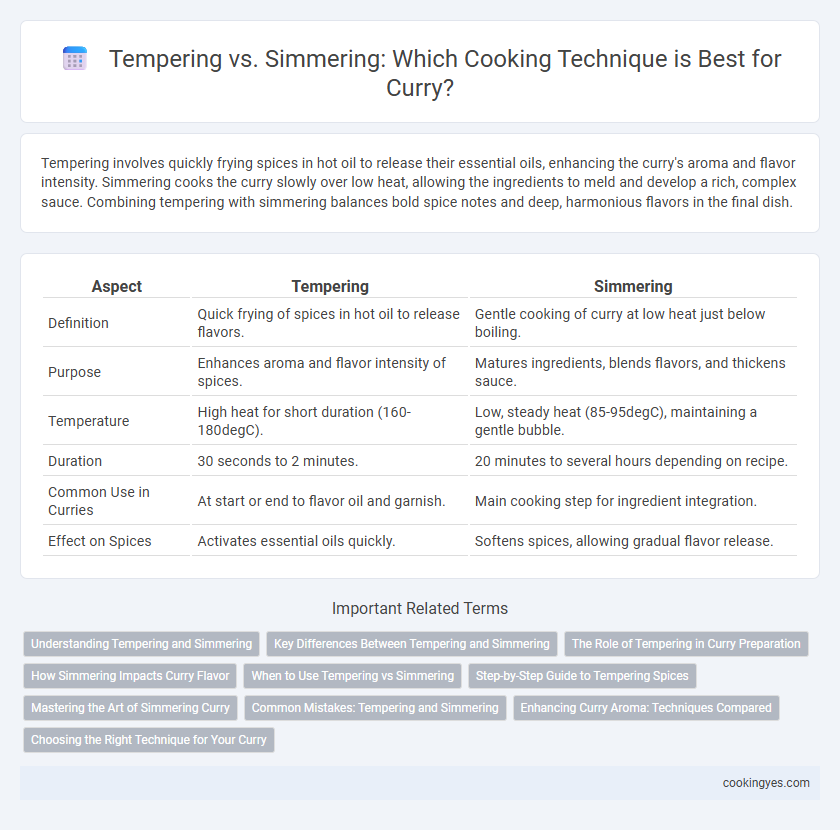Tempering involves quickly frying spices in hot oil to release their essential oils, enhancing the curry's aroma and flavor intensity. Simmering cooks the curry slowly over low heat, allowing the ingredients to meld and develop a rich, complex sauce. Combining tempering with simmering balances bold spice notes and deep, harmonious flavors in the final dish.
Table of Comparison
| Aspect | Tempering | Simmering |
|---|---|---|
| Definition | Quick frying of spices in hot oil to release flavors. | Gentle cooking of curry at low heat just below boiling. |
| Purpose | Enhances aroma and flavor intensity of spices. | Matures ingredients, blends flavors, and thickens sauce. |
| Temperature | High heat for short duration (160-180degC). | Low, steady heat (85-95degC), maintaining a gentle bubble. |
| Duration | 30 seconds to 2 minutes. | 20 minutes to several hours depending on recipe. |
| Common Use in Curries | At start or end to flavor oil and garnish. | Main cooking step for ingredient integration. |
| Effect on Spices | Activates essential oils quickly. | Softens spices, allowing gradual flavor release. |
Understanding Tempering and Simmering
Tempering involves briefly frying spices in hot oil to release their essential oils and enhance the flavor profile of a curry, creating a more aromatic and intense dish. Simmering refers to cooking the curry ingredients gently at a low temperature, allowing the flavors to meld and develop depth over time without boiling. Mastering tempering and simmering techniques significantly improves the complexity and balance of curry dishes.
Key Differences Between Tempering and Simmering
Tempering involves briefly frying spices in hot oil to release their flavors and aromas before adding them to the curry, enhancing the dish's depth and complexity. Simmering refers to cooking the curry slowly at a low temperature to allow ingredients to meld together and develop a rich, balanced flavor profile. The key difference lies in tempering's focus on flavor extraction through intense heat at the beginning, while simmering emphasizes gentle, prolonged cooking to tenderize ingredients and integrate spices uniformly.
The Role of Tempering in Curry Preparation
Tempering in curry preparation involves heating whole spices in hot oil to release their essential oils, intensifying the flavor and aroma before adding other ingredients. This technique creates a rich, layered taste profile by infusing the oil with the spices, which then evenly distributes throughout the curry. Unlike simmering, which gently cooks the curry to meld flavors over time, tempering acts as a flavor enhancer at the initial stage of the cooking process.
How Simmering Impacts Curry Flavor
Simmering allows spices and ingredients in curry to gradually release their flavors, resulting in a rich and harmonious taste profile. The gentle heat preserves the integrity of delicate herbs while blending robust spices deeply into the sauce. This slow cooking method enhances the complexity and depth of the curry's aroma and texture, distinguishing it from the sharper, more immediate impact of tempering.
When to Use Tempering vs Simmering
Tempering is best used at the beginning or end of cooking to infuse hot oil with spices, releasing intense flavors that enhance the curry's aroma and taste. Simmering is ideal for cooking the main ingredients slowly, allowing spices and other flavors to meld thoroughly within the sauce for a rich, balanced curry. Choose tempering for immediate flavor bursts and simmering for deep, integrated taste development.
Step-by-Step Guide to Tempering Spices
Tempering spices involves heating whole or ground spices in hot oil or ghee to release their essential oils and enhance flavor before adding them to the curry. Begin by heating oil in a pan over medium heat, then add mustard seeds or cumin seeds until they start to pop, followed by dried red chilies, curry leaves, and other desired spices for 30 to 60 seconds. This technique concentrates the spices' aroma and taste, creating a richer, more vibrant curry compared to simmering spices directly in the sauce.
Mastering the Art of Simmering Curry
Simmering curry involves cooking ingredients gently in liquid at a low, steady temperature, allowing spices and flavors to meld deeply without burning. Tempering, or tadka, is a quick technique where whole spices are briefly fried in hot oil or ghee to release aromatic oils before being added to the curry, enhancing its flavor profile. Mastering simmering ensures a rich, cohesive curry base, while tempering introduces bursts of fragrance and complexity essential for authentic Indian dishes.
Common Mistakes: Tempering and Simmering
Common mistakes in tempering include overheating the oil, which can burn spices and impart bitterness to the curry, and adding spices too early, causing loss of aroma and flavor. Simmering errors often involve cooking at too high a temperature, leading to tough meat and uneven flavors, or not allowing enough time for ingredients to meld, resulting in a lack of depth. Proper control of heat and timing is crucial for balancing tempering and simmering techniques and achieving rich, authentic curry flavors.
Enhancing Curry Aroma: Techniques Compared
Tempering involves frying whole spices in hot oil to release essential oils that intensify the curry's aroma, creating a vibrant and fresh flavor profile. Simmering allows spices to infuse slowly into the curry, blending flavors deeply but with a subtler scent. Using tempering at the start or end of cooking maximizes aromatic impact, while simmering ensures even flavor distribution throughout the dish.
Choosing the Right Technique for Your Curry
Tempering involves briefly frying whole spices in hot oil to release their essential oils and enhance aroma, making it ideal for dishes requiring a punch of flavor at the start. Simmering gently cooks ingredients in liquid over low heat, allowing spices and flavors to meld deeply, perfect for curries needing rich, slow-cooked profiles. Selecting tempering or simmering depends on the desired intensity and integration of spices in your curry, balancing vibrant fragrance with savory depth.
Tempering vs Simmering for cooking technique Infographic

 cookingyes.com
cookingyes.com